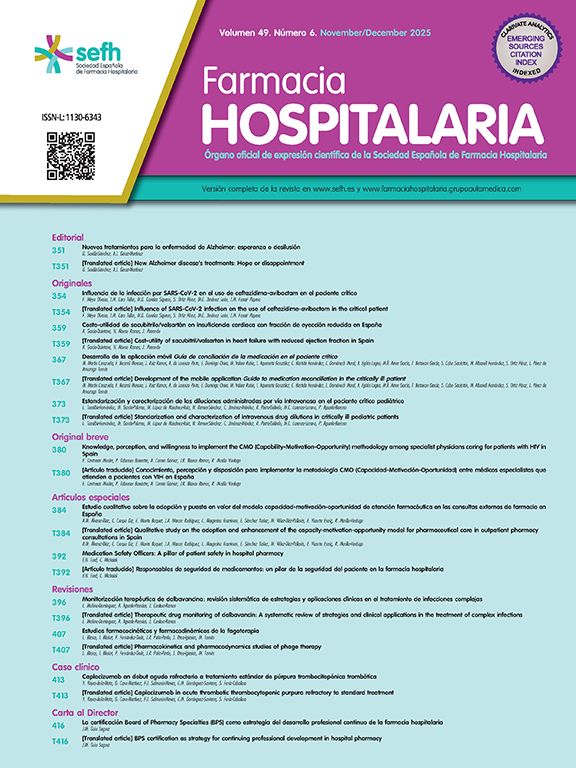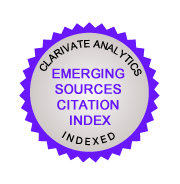
The logical path followed by pharmacotherapy since time immemorial has taken it from the gathering of scientific knowledge in selected populations to its translation to specific patients using objective and measurable criteria. This scientific evidence, which lies at the base of clinical practice has traditionally been obtained from controlled clinical trials. This axiom, whose foundations were laid in the 20th century, generated the movement known as evidence-based medicine1.
This editorial is a reflection on two advances that are revolutionizing pharmacotherapy in the 21st century: the use of real-world data (RWD) to obtain new therapeutic evidence, and the availability of biomarkers, which are key milestones on the path towards the promise of precision medicine. Both breakthroughs are intimately connected to technological innovation and require an urgent reform of academic and clinical training so that healthcare providers can keep abreast of the latest developments and be able to understand, interpret and use the new knowledge for the benefit of patients and society at large.
From a broad pragmatic standpoint, the term RWD should be applied when making reference to data obtained from non-experimental, i.e., non-controlled, studies, with no intervention of the investigator2. This may include data from a wide range of sources, among them electronic medical records, disease registers or less common sources such as patient complaints3. Real word evidence (RWE) for its part must be understood as a kind of clinical evidence based on the analysis of RWD3.
The body of knowledge obtained from traditional clinical trials suffers from certain well-known limitations, mainly though not exclusively associated with the applicability of their findings to the population at large. Over 15 years ago, a pioneering editorial of our journal discussed the need to transfer the results of research to clinical practice through the performance of pragmatic clinical trials and observational studies4. To avoid biases and incorrect conclusions5, two key dimensions of RWE must be taken into consideration: firstly, the environment where the evidence is obtained and secondly the methodology used for its generation. Medicines regulatory agencies avail themselves of several tools to perform a critical analysis of RWE-based reports. Such tools, which explore different key methodological areas, are identical to those used for the critical interpretation of observational studies (e.g., the well-known Newcastle-Ottawa scale)6. Unfortunately these tools are generally little known and scarcely used by healthcare providers.
From the foregoing one could perhaps draw the hasty (yet logical) conclusion that RWD/RWE studies are more related to post-marketing research than to the documentation required to obtain the authorities’ approval for the new drugs, where the traditionally (and justifiably) agreed standard is the phase III randomized controlled trial. This would however be a serious mistake. Between 2017 and 2019, five hemato-oncologic drugs (avelumab, pembrolizumab, palbociclib, lutetium 177 dotatate and blinatumomab) received FDA approval for different indications based on retrospective studies containing one single arm (i.e., with no comparator), despite the limitations flagged by FDA reviewers (small sample size, selection bias, confounding bias, etc.)7. The list could be completed by adding two more CAR-T cell drugs that have had a significant clinical, economic, organizational and media impact: axicabta-gene ciloleucel and tisagenlecleucel.
It should not be forgotten that RWD and RWE are used as a basis for large sample size cohort studies, with the methodological biases that such studies may entail. In a recent review8 of 293 RWD studies on antineoplastic drugs, 78% of the studies analyzed were shown to be of low quality according to the Newcastle-Ottawa scale. RWE can under no circumstances be used as an alibi to question (or to replace) the findings of well-designed controlled clinical trials, which remain the gold standard in biomedical research.
The second milestone of the new pharmacotherapy is the type of data used to generate scientific evidence, data that are increasingly available to healthcare professionals from clinical laboratories. Although the ways in which population-based data are obtained are now extremely varied, the type of data used to obtain evidence and translate it to the patient's bedside has experienced an even greater change as a result of the advent of RWD-based studies.
It should be remembered that “pharmacotherapeutic personalization” is not alien to hospital pharmacy as a healthcare profession. Undoubtedly, the methodology and the tools used over the last few decades to make personalization possible have changed. Initially, they consisted merely in adjusting the dosage of the drugs administered to the patients’ anthropometric and clinical characteristics (weight, age, sex, comorbidities, etc.) in order to improve efficacy and reduce toxicity. Later on, analytical techniques were developed to determine the concentration of drugs in biological fluids which, together with the use of appropriate pharmaco-statistical models, heralded the advent of clinical pharmacokinetics.
Nowadays, the profession has taken a step further, moving from personalized pharmacotherapy to precision medicine (PM), a concept that was used for the first time in 2011 in a report by the US National Academy of Sciences, which laid the foundations for a new taxonomy of diseases based on molecular biology. The report defined PM as an emerging approach to the treatment and prevention of diseases, which takes into consideration inter-individual genetic variability, the environment and each person's lifestyle9. It should be noted that the genetic determinism associated with the genome represents only one part of the approach to PM, suggesting the low predictive power that genes have by themselves9. In fact, some authors believe that biomarkers do not automatically allow a determination of the causes of a disease; instead, statistical methods are used to find out susceptibilities, i.e. statistical associations are established between a biological indicator and a health outcome10, which could result in the appearance of “pre-symptomatic patients” or persons treated for their proneness to develop a certain disease, giving rise to the belief that life is an ominous wait until disease rears its ugly head11.
Oncology is the area where PM has most enthusiastically incorporated new genomic technologies for identification of the molecular profiles and the biomarkers of certain tumors, and the corresponding use of targeted medicines, dedicated particularly to immune-oncology therapy. The steps needed to appropriately validate these biomarkers (clear aim, appropriate data source, correct statistical calculations, independent validation of results)12 are not always taken with the rigor required, which often leads to an overestimation of their real value13. The efficacy of oncologic pharmacotherapy has not increased apace with the evolution of biomarker determination techniques, probably because of the genetic heterogeneity of tumors, which gives rise to a selection of unmarked clones resistant to targeted therapy9. According to the currently available evidence, PM approaches may entail clinical gains in certain niche areas or individual cases (accounting for only 2-6% of patients)14 and their effectiveness remains to be demonstrated by well-designed clinical trials on specific subgroups.
One of the most exciting promises of PM is the possibility to reduce healthcare costs by administering a drug only to those patients where it has been shown to be safe and effective. However, this promise has not materialized. Far from that, the high cost of targeted therapies has created inequalities in the access to treatments and become a threat to the sustainability of health systems9. Although numerous groups are working on improving the efficacy of PM as applied to oncological processes, the significant increases in the cost of treatments (which are a reflection of their market acceptability rather than of the actual clinical benefit they provide) has seldom been accompanied by improved health outcomes15.
As mentioned above, healthcare providers are currently facing interesting challenges in the realms of evaluation and interpretation of drug-related clinical outcomes. The response to such challenges should be based on multidisciplinary collaboration and training in the development of new tools, new knowledge and new evidence. This special issue of Farmacia Hospitalaria includes a compilation of an interesting series of articles and reviews related with the personalization of drug therapy intended to encourage hospital pharmacists to further their knowledge in this area. This special issue was put together as a tribute to the myriad specialist hospital pharmacists who give their all to serve their patients in this complex clinical field.






